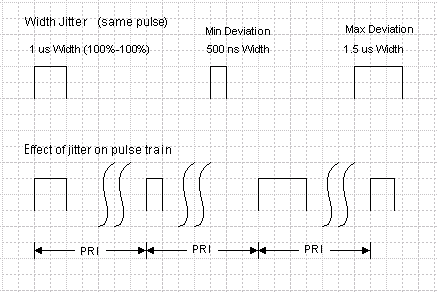
The Jitter Type parameter is described as the change in the time duration, or on-time, of the pulse. The width of the pulse is lengthened and shortened by jitter. The jitter is applied to the falling edge of the pulse; the leading edge is not changed by this parameter.
The Pulse Building application provides the following types of jitter:
- no jitter applied to the pulse.
- jitter on the falling edge of the pulse is applied using a Gaussian probability distribution function model.
- jitter on the falling edge of the pulse is applied using a uniform probability distribution function model.
- jitter deviation is applied using a U-shaped distribution.
The figure below shows how a pulse with a 1 us Width (100%-100%) with jitter applied to the width will vary. In addition the figure shows the effect of width jitter on a pulse train. Note that the pulse repetition rate remains constant. The maximum width excursion depends on the jitter deviation and type of deviation. In the figure below the jitter deviation is 500 ns. The number of pulse widths generated with jitter is specified using the Repeat parameter. See also Pattern Details.
